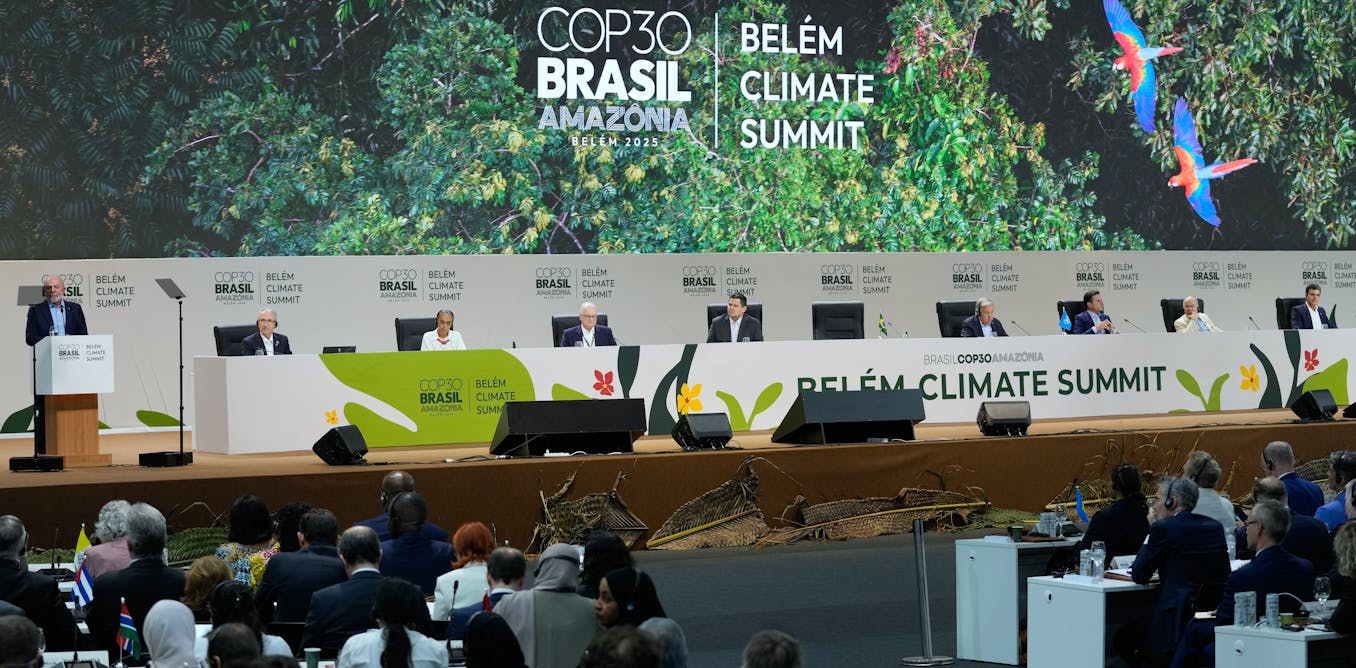Billions of dollars are currently being poured into a technology that doesn’t actually exist. Governments are drafting regulations for it. Universities are reorganizing research priorities around it. Think tanks are hosting roundtables about it.
No one can say exactly when, or even if, this technology — artificial general intelligence (AGI) — will arrive. Yet the idea of it is already shaping budgets, careers, and policy. The story of AGI is acting like infrastructure for the tech, inspiring the systems and structures needed to actually bring it to fruition.
This is not an anomaly. Progress in steel and silicon has long been preceded by progress in imagination. Jules Verne’s novels prepared readers for submarines and space travel. Star Trek’s communicator device inspired engineers to create the mobile phone. Douglas Engelbart’s famous “Mother of All Demos” showed a mouse and hypertext before most people had touched a computer — a generation of researchers left his talk determined to build what they had just seen.
On the Foresight Institute’s Existential Hope podcast, I’ve heard many versions of the same story. Someone reads Douglas Hofstadter as a teenager and starts thinking seriously about intelligence. Someone else discovers Richard Feynman and realizes curiosity itself could be a vocation. Another encounters Eric Drexler and begins imagining technology as world-shaping. Each version is different, but they all follow the same pattern: a story tips curiosity into commitment.
We usually think of infrastructure as bridges, satellites, and fiber-optic cables. But beneath steel and concrete lies something less tangible but just as powerful: culture — the stories and symbols that make some futures seem absurd, others inevitable, and a few worth building.
Culture kickstarts progress
Progress rests on multiple layers. At the top is hard infrastructure: bridges, laboratories, power grids, and rockets. Beneath that lies soft infrastructure: laws, institutions, and systems that make the hardware useful. And beneath both rests a third layer: invisible infrastructure. Culture. The stories, narratives, and memes that determine which futures feel plausible and worth pursuing.
This layer is easy to overlook because it doesn’t leave behind blueprints or legislation. Yet history shows its importance. The Enlightenment was not an engineering project but a cultural shift. In coffee houses and pamphlets, curiosity and reason became public virtues. That shift created the conditions for modern science and the Industrial Revolution. The machines were built in workshops, but the idea that machines could transform the human condition was built in culture first.
Progress studies itself can be seen as a cultural movement as much as a research agenda. By reframing “progress” as something to be studied, measured, and deliberately pursued, it has opened a new intellectual space. The questions it raises — Why did progress accelerate in the past? Why did it slow? How might it be revived? — are cultural provocations as much as analytical ones. They change how people think about the future, and that change in turn shapes what gets funded, what policies are debated, and what careers bright young people choose.
Hard infrastructure builds the roads. Soft infrastructure sets the rules of the road. Culture decides which destinations are worth visiting.
From fiction to fact
Scientist Michael Nielsen has given us a useful term for understanding how culture shapes progress: the hyper-entity. He defines it as an “imagined hypothetical future object or class of objects” — something that exists in the collective consciousness before (maybe) becoming reality. Today’s hyper-entities include AGI, space elevators, Martian settlements, the Singularity, and universal quantum computers. Past examples might be things like the internet, submarines, and cell phones — they began as cultural ideas before becoming real objects.
Some hyper-entities are still making the transition from imagined to real. In 1984, writer William Gibson coined the term “cyberspace” in his debut novel, Neuromancer. At the time, hardly anyone outside research labs had used a computer network. Yet Gibson’s imagery — hackers, networks, and virtual worlds — provided a cultural vocabulary. Policymakers and engineers didn’t encounter the internet as a blank slate. They met it through the cyberspace lens, which continues to shape debates about privacy, monopoly power, and online identity.
The solarpunk movement is rich with hyper-entities: neighborhoods powered entirely by renewables, cities interwoven with greenery, technology in service of ecological balance. Designers, architects, and community projects already draw inspiration from it. Like cyberpunk before it, solarpunk could grow from a hyper-entity into reality. It provides a cultural framework that makes sustainable futures feel intuitive.
Hyper-entities can magnify human potential, but they can just as easily magnify inertia.
National projects can start as hyper-entities as well. The Apollo program didn’t begin with rockets. It began with a story. President Kennedy’s line, “We choose to go to the Moon,” transformed space exploration into a cultural commitment. That story outlasted Apollo, evolving into the broader hyper-entity of “space exploration” that still mobilizes engineers, investors, and governments to go deeper into the unknown.
The Green Revolution shows the same pattern. After World War II, hunger was cast as a global challenge and “feeding the world” as a moral imperative — humanity began to imagine a future where no one went to bed hungry. That narrative mobilized scientists, philanthropies, and governments to scale improved crops and irrigation, saving hundreds of millions of lives. Seeds and canals mattered. So did the story that inspired them.
Yet hyper-entities are not always benign. Once they move from the imagination to the real world, they can take on unforeseen characteristics or become rigid and incapable of evolving with the times. The modern education system, once a breakthrough in spreading knowledge, is now often criticized for lagging behind the needs of a changing world. Bureaucracies, once cultural advances in coordination, can calcify into obstacles. Hyper-entities can magnify human potential, but they can just as easily magnify inertia.
And today, AGI is perhaps the most powerful hyper-entity. It doesn’t exist yet, but the story of AGI already shapes budgets, regulation, research agendas, and the careers of thousands. It may never arrive, but for now, the idea itself is acting as cultural infrastructure, organizing effort across society.
The power of memes
If hyper-entities are the heavyweights of culture, then memes are its quick strikes.
While hyper-entities are deep, slow-moving structures that will take decades to form, memes are lighter, faster packets of culture: a phrase, an image, an idea designed to be shared and adapted. Richard Dawkins coined the term in 1976 to describe a small unit of cultural transmission. Since then, it has come to mean everything from online jokes to political slogans.
Most memes burn out quickly, but some prove powerful. A few compress complicated ideas into such simple, contagious forms that they shape how people think and act at scale.
Memes aren’t just trivial distractions.
“Move fast and break things” began as an internal motto at Facebook. Within a few years, it had spread across Silicon Valley, becoming shorthand for the entire startup ethos: experiment quickly, worry less about rules, and treat disruption as a virtue. Five words shifted an industry’s attitude.
“Flatten the curve” worked the same way for public health. At the start of the COVID-19 pandemic, complex epidemiological models struggled to cut through. Then a simple diagram of two curves, paired with a phrase, raced across the internet. Within weeks it had changed how millions of people thought about masks, vaccines, and lockdowns.
Memes aren’t just trivial distractions. The most powerful ones act as cultural infrastructure in miniature: accelerators that can shift public behavior, set the tone of whole industries, or make far-off futures feel urgent. If hyper-entities are the foundations of cultural life, memes are the sparks that can change its direction almost overnight.
When stories stop progress
Sparks don’t always start the fires you want, though. The same speed that makes memes powerful also makes them volatile. And what’s true for memes is true for culture more broadly: It doesn’t always drive society forward.
The pattern is simple. Culture magnifies, but it does so indiscriminately — it can amplify fear as easily as hope, mistrust as easily as trust, and rigidity as easily as flexibility. Sometimes culture stalls innovation. Genetically modified crops promised higher yields and reduced pesticide use, but public fear — shaped by stories of “Frankenfoods” — slowed adoption in many parts of the world, including places where GMOs might have reduced hunger and improved health.
Nuclear power tells a similar story. Statistically, it’s one of the safest and cleanest energy sources we have. Nevertheless, it has been hobbled by the cultural shadow of Chernobyl and The China Syndrome. In some countries, these narratives mattered more than the data.
Even when culture pushes technologies forward, it can saddle them with unintended baggage. The cyberpunk genre gave us the word “cyberspace,” but also a lens of paranoia and dystopia that still shapes internet policy. “Move fast and break things” energized a generation of startups, but it also normalized a kind of carelessness that society could still be paying for.
Culture is infrastructure, yes, but it is infrastructure that’s more like weather than bridges: largely unpredictable and sometimes destructive. And this volatility is precisely why the tone of culture matters. Left unchecked, fear and cynicism fill the space. To channel culture toward constructive ends, we need something sturdier: hope.
Hope, not optimism
The Enlightenment, the Apollo program, and even today’s debates over AI all show that progress depends not only on technology and institutions, but also on our feelings about the future. Are we complacent, fearful, or hopeful?
Optimism assumes things will work out no matter what. It’s a sunny outlook, but a passive one. If progress is guaranteed, there’s little reason to struggle for it. Fear can be motivating, but it tends to mostly mobilize defensive action. The story of nuclear annihilation led to arms-control treaties and fallout shelters. Dystopian visions of AI fuel safety research and regulation. These are necessary, but they are responses to threats, not investments in possibilities.
Hope is active where optimism is passive. Hope assumes risk and uncertainty. It isn’t blind to challenges, but it believes they can be navigated. Hope doesn’t wait for good outcomes to arrive on their own. It frames progress as something worth fighting for.
History shows the power of hopeful infrastructure.
Thinkers in the progress movement have wrestled with this distinction. Jason Crawford, founder of the Roots of Progress Institute, for example, has contrasted “complacent optimism” with more constructive modes, such as “pragmatic optimism” or “radical optimism.” Complacent optimism assumes progress will happen automatically. Pragmatic optimism insists it can happen, but only if we work for it. These terms are useful because they remind us that hope is not about assuming the future will be bright; it is about deciding to make it so.
History shows the power of this hopeful infrastructure. The Enlightenment wasn’t naïve. Its thinkers were well aware of ignorance and war, and yet they cultivated hope in reason and experiment. That stance built scientific societies, universities, and newspapers — institutions that turned curiosity into a permanent driver of progress.
The Apollo program further illustrates the point. When Kennedy stood at Rice University and declared, “We choose to go to the Moon,” it wasn’t a guarantee of success. The risks were enormous, and failure was a live possibility. Though the Cold War rivalry loomed large, the decision wasn’t driven by fear alone, either. The speech framed space travel as a hopeful human project, one difficult enough to be worth doing and inspiring enough to justify the cost and danger. That hopeful framing created the cultural momentum that made the rockets possible.
In my own work, I’ve noticed how often people look puzzled when asked to imagine positive futures. They can easily list disasters — pandemics, climate collapse, runaway AI — but when pressed for hopeful scenarios, they hesitate. That hesitation is telling. It shows how little scaffolding mainstream culture gives us for constructive imagination.
When people reach for cultural references to make sense of the future, the ones closest to hand are almost always bleak.
In mainstream culture, hopeful futures rarely get the same airtime as dystopias, which saturate film, television, and streaming — Black Mirror, The Hunger Games, Don’t Look Up. By contrast, brighter visions of tomorrow remain niche, appearing in Kim Stanley Robinson’s climate fiction, Eric Drexler’s Pareidotopia, and Iain M. Banks’ Culture series.
While these hopeful visions exist, they don’t dominate the shelf space, and that imbalance is important. It means that when people reach for cultural references to make sense of the future, the ones closest to hand are almost always bleak.
The AGI debate shows why this distinction matters now. A purely dystopian frame may lock down research without preparing for benefits. A purely utopian frame invites recklessness. A hopeful frame treats AGI as powerful but steerable, and it could bring governance, investment, and innovation into alignment.
Investing in culture
Earlier, I described progress as resting on three layers: hard infrastructure, such as labs and power grids; soft infrastructure, such as laws and institutions; and invisible infrastructure, in the form of culture. Economic infrastructure connects these layers. It is the bridge that carries cultural seeds from the invisible layer into the visible ones. Without it, stories and symbols risk remaining visions only. With it, they can become technologies, policies, and institutions.
Funding is never just financial. It is cultural. When venture capitalists pour billions into startups they send a signal: This field is worth building. The dot-com boom of the 1990s wasn’t only about technology. It was a cultural moment that normalized “founder” as a career. Today, the surge of funding around AGI tells a generation of young people that this, too, is a frontier.
Philanthropy and public funding can play the same role in neglected areas. Investments in longevity, space, or climate studies don’t just move the science forward; they legitimize the idea that these are worthy pursuits. Money, in this sense, is cultural scaffolding as much as material support.
Most of the cultural ground we’ve laid is dominated by dystopias, and that imbalance won’t correct itself.
The same is true for art and entertainment. Popular culture often shapes the collective imagination more effectively than white papers or policy memos. Films, TV shows, video games, and even music tell us what kind of futures to expect. Right now, those futures are mostly dystopian. If we want hopeful culture to have a fighting chance, commissioning and supporting art that portrays positive futures may matter as much as funding labs.
That suggests a concrete step: treat culture as a line item in the portfolio of progress, just as we treat laboratories or laws. That means commissioning stories, funding prototypes, testing memes, and backing the kinds of cultural experiments that can scale. If culture is infrastructure, we should budget for it, using economic infrastructure as the bridge that turns imagination into reality.
AGI may not exist, but the story of AGI already mobilizes billions of dollars. That shows how culture lays the groundwork before a technology ever arrives.
The problem is that most of the cultural ground we’ve laid is dominated by dystopias, and that imbalance won’t correct itself. It needs deliberate work, not only from institutions and funders, but from all of us. Culture isn’t just made in conferences or boardrooms. It is shaped in the stories we tell, the art we share, and the memes we pass along. Everyone participates.
Economic infrastructure is the bridge that carries culture into the world: from invisible symbols, to soft institutions, to hard technologies. Culture is unpredictable, double-edged, and too important to ignore. If we want progress to keep moving, we need to balance our culture of fear with visions of hope, and then back those visions with the resources they need to become real.
This article Why culture may be our most powerful lever for progress is featured on Big Think.

The post “Why culture may be our most powerful lever for progress” by Beatrice Erkers was published on 11/19/2025 by bigthink.com






































Leave a Reply